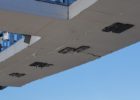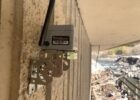How Wireless and IoT Slope Monitoring Systems Help Detect Landslides
Slope instability remains one of the most persistent threats to infrastructure, human safety, and environmental sustainability. In landslide-prone regions, traditional monitoring techniques often fall short due to their reactive nature and limitations in real-time data capture. Today, wireless and IoT-enabled slope monitoring systems offer a smarter, more proactive approach.
Advanced slope monitoring instruments, including wireless strain and displacement sensors, are changing the way engineers, governments, and asset managers manage landslide risk and maintain slope stability.

What Is Slope Monitoring and Why Is It Needed?
Slope monitoring refers to the continuous observation of ground movement and changes in slope conditions using specialized sensors. Factors like excessive rainfall, seismic activity, nearby construction, or erosion can disturb the natural stability of slopes, causing sudden landslides. According to the United Nations Office for Disaster Risk Reduction, landslides account for thousands of deaths and billions in damages annually.
Inadequate slope stability monitoring has contributed to preventable disasters from collapsed roads to compromised dam embankments and damaged rail lines. The growing frequency of such events has led governments and industries to adopt smarter, real-time slope monitoring systems.
Challenges with Traditional Slope Monitoring Methods
Conventional approaches to slope monitoring such as periodic manual inspections, borehole readings, or survey equipment, suffer from several limitations:
- Lack of Real-Time Data: Most methods don’t offer continuous monitoring.
- High Operational Costs: Regular site visits and manual readings are time and labor-intensive.
- Limited Coverage: Remote or hazardous terrains are often inaccessible.
- Delayed Response: Early signs of instability may go unnoticed between inspection intervals.
These gaps underscore the need for wireless, low-power, and high-accuracy slope monitoring instruments.

The Role of Wireless and IoT-Based Slope Monitoring Systems
Wireless and IoT-enabled slope monitoring systems offer a more scalable, cost-effective, and accurate way to track changes in slope conditions. Here’s how they work:
Real-Time Data Collection
Resensys offers a suite of products for monitoring slopes in areas at risk of landslide. This includes:
- Wireless tiltmeter: Monitor slope stability and changes in the orientation.
- Wireless displacement gauges: Monitor displacement and crack activity in structures such as retaining walls and check dams, which are installed to prevent ground movement.
- Data Acquisition Gateways with camera systems: Provide visual feedback from the slopes.
IoT-based sensors, such as Resensys’ Wireless Enhanced Strain Gauge IoT SenSpot™ and Wireless Enhanced Displacement Gauge IoT SenSpot™, transmit real-time data on strain, displacement, and structural behavior. This enables early detection of potential slope failures.

Applications Across Industries
Resensys’ slope monitoring systems are adaptable across a wide range of industries and infrastructure types:
- Transportation Infrastructure: Monitor highway embankments, cut slopes, and railway lines vulnerable to washouts or deformation.
- Mining and Quarrying: Track slope movement in open-pit mines to prevent wall failures and ensure worker safety.
- Dams and Reservoirs: Use slope monitoring instruments to assess settlement, tilting, and potential seepage risks near embankment zones.
- Urban Development: Evaluate slope integrity near excavation zones or areas with poor soil conditions during high-rise or tunnel construction.
- Remote and Mountainous Regions: Enable slope stability monitoring in areas where access is restricted or infrastructure is aging and unmonitored.
In each of these applications, real-time monitoring enables stakeholders to react early before a small shift escalates into a catastrophic event.
Integration with Central Monitoring Systems
All Resensys sensors, including IoT-enabled options like the Enhanced Strain Gauge IoT SenSpot™ and Enhanced Displacement Gauge IoT SenSpot™, integrate seamlessly with the company’s proprietary data management platform. This central system enables project managers, engineers, and maintenance personnel to track real-time values and trends through a user-friendly dashboard.
Alerts can be configured for predefined thresholds such as excessive tilt, displacement, or strain enabling proactive responses. The slope monitoring system becomes more than just a data collector, it acts as a decision support tool that enhances planning, budgeting, and risk management.
Whether you’re overseeing a critical transportation corridor or a high-stakes mining operation, the value of a connected and intelligent slope monitoring instrument lies in its ability to guide timely, informed action.
Why Resensys for Slope Monitoring?
With over a decade of experience in remote structural health monitoring, Resensys brings proven technology and deep field expertise to the complex challenge of slope stability monitoring. Our systems are:
- Easy to deploy with no need for external power or complicated wiring.
- Highly scalable accommodating small local setups or large distributed networks.
- Proven in extreme conditions including snow, floods, heat, and vibration.
- Backed by real-world case studies across bridges, embankments, retaining walls, and more.
Whether you’re facing regulatory pressure, public safety concerns, or logistical limitations, Resensys’ slope monitoring instruments offer the precision and flexibility needed to maintain safe, operational infrastructure over time.
Learn how our slope monitoring solutions can be customized to your infrastructure needs. Reach out to us today.


